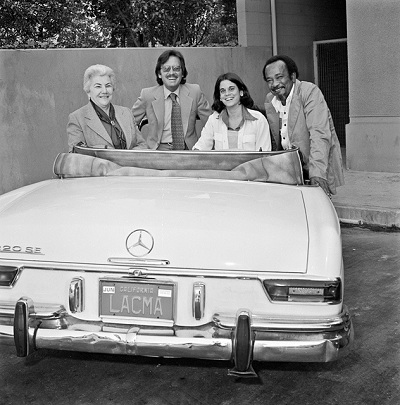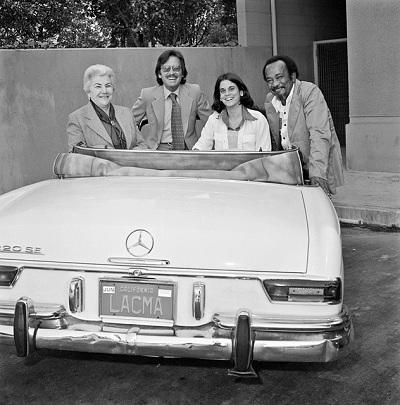Former LACMA curator and community activist Cecil Fergerson believed in the power of art as a lightning rod for discussion and, most importantly, a catalyst for change. Moving through an incredibly challenging period in America, Fergerson left an indelible mark on the history of art at LACMA.
 Unknown photographer, Betty Asher, Maurice Tuchman, Stephanie Barron, and Cecil Fergerson in Tuchman's Mercedes, December 1977, Los Angeles County Museum of Art Photography Archives, photo © 2008 Museum Associates/LACMA
Unknown photographer, Betty Asher, Maurice Tuchman, Stephanie Barron, and Cecil Fergerson in Tuchman's Mercedes, December 1977, Los Angeles County Museum of Art Photography Archives, photo © 2008 Museum Associates/LACMA
When I arrived at LACMA at the beginning of 2010, one of my earliest encounters was with Cecil Fergerson. I had been told many things about this man and was happy he had agreed to sit down with me at his home. Sure, there was mutual admiration from a shared vocation, but it was also the familiar way that the older generation greeted young newcomers who share mutual friends. Perhaps feeling her husband could come off as a little gruff, his wife, Miriam, was welcoming and warm, as if she were my own grandmother. Cecil enjoyed talking, most especially about art and activism. I didn't get back as much as I would have liked, but we did manage to share some stories along the way. The first sight of his kufi and long dashiki at public events promised fireworks, or at least there was going to be a lively riposte at some point!
Fergerson’s story was improbable, but true. He was born in Oklahoma in 1931 and moved with his family to Los Angeles in 1939. He started working at LACMA—which was still a part of the Los Angeles County Museum of History, Science, and Art in Exposition Park—in 1948 as a janitor. By 1964, he became an art preparator and was later named a curatorial assistant in 1972. In between, at the height of the civil rights movement, Fergerson and his colleague Claude Booker began calling for the presence of black American artists in the museum’s exhibitions. Together they formed the Black Arts Council in 1968.
The group’s work led to a series of lectures and two exhibitions: Three Graphic Artists: Charles White, David Hammons, and Timothy Washington in 1971 and Panorama in 1972. The latter included artists Noah Purifoy, John Outterbridge, and Betye Saar. The Black Arts Council’s efforts led to LACMA’s initiation and support of the exhibition Two Centuries of Black American Art in 1976, which traveled to the High Museum in Atlanta, the Dallas Museum of Fine Arts, and the Brooklyn Museum. Before organizing these two exhibitions, Fergerson had made his mark on another important LACMA project, assisting with the Art and Technology Program, which traveled to Expo '70 in Osaka, Japan. Cecil traveled with the show.
“When I arrived at LACMA in 1976 Cecil Furgeson was a curatorial assistant in the department of modern art. He particularly enjoyed working with artists, and one of his proudest accomplishments was working on the Art and Technology show that opened at the museum in 1971," said Stephanie Barron, LACMA's senior curator of Modern art. "Artists loved working with Cecil—he always said anything was possible—and then would figure out how to make it work. I learned a lot from Cecil. I had to prove myself to him. He was a tough critic. But once I won his respect and admiration, we enjoyed a terrific relationship. When Cecil left the museum, we lost someone very special—but I was so proud of what he accomplished in the community. He was a remarkable man and someone I will miss very much.”
Fergerson retired from the museum in 1985 and began his second career as an activist curator and organizer of exhibitions in diverse spaces around Los Angeles, always promoting black artists.
Recently LACMA rekindled the flame that Fergerson set alight through his participation. Austen Bailly, former curator of American art, said recently, “I love that we were able to bring Cecil into conversations at LACMA through our programming and online archives about the Black Arts Council and Two Centuries of Black American Art, and that he could share his incredible stories and views about the museum and black art and artists with old and new audiences. What an inspiration. The momentum we have around expanding collections and exhibitions and audiences and supporters and enlarging our community is due to the foundations Cecil laid at LACMA over decades. Rest in peace.”
If he were not an invited participant in recent years, he was surely there agitating as a respondent. The long-term loan of a work by John Biggers was celebrated by a panel discussion with Fergerson’s peers Samella Lewis and Bill Pajaud, in addition to the Houston art collector Bill Perkins. In 2011, LACMA held a 35th-anniversary celebration for Two Centuries of Black American Art, with a keynote from David Driskell (who also led the panel discussion), the scholar Bridget Cooks, and Fergerson. In 2012, Austen Bailly led a discussion, "Building Collections of African American Art," in which Halima Taha moderated a discussion with collectors Jesse Williams and Aryn Drake-Lee, Lyndon and Janine Barrois, and Paul and Linda Gotskind. LACMA also acquired an important document from the era of Fergerson’s Black Arts Council. The Ruth Waddy Sketchbook consists of 130 drawings by various artists from 1968 through 1981. In fact, Waddy, Lewis, and Fergerson formed a kind of triumvirate of voices and support for L.A. artists.
Cooks offers, “Fergerson was an advocate and agitator for black artists, the impact of which has spread across the nation. He encouraged and mentored three generations of people in the L.A. art scene through his example of activism and collecting.”
He will be missed.
Franklin Sirmans, Terri and Michael Smooke Curator and Department Head, Contemporary Art



